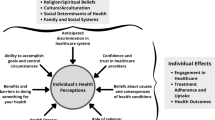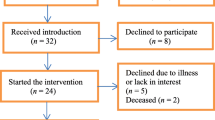Abstract
Large groups in society, in particular people with low literacy, lack the necessary proactivity and problem-solving skills to be self-reliant. One omnipresent problem area where these skills are relevant regards filling in forms and questionnaires. These problems could be potentially alleviated by taking advantage of the possibilities of information and communication technology (ICT), for example by offering alternatives to text, interactive self-explaining scales and easily accessible background information on the questionnaires’ rationale. The goal of this paper was to present explorative design guidelines for developing interactive questionnaires for low-literate persons. The guidelines have been derived during a user-centered design process of the Dutch Talking Touch Screen Questionnaire (DTTSQ), an interactive health assessment questionnaire used in physical therapy. The DTTSQ was developed to support patients with low health literacy, meaning they have problems with seeking, understanding and using health information. A decent number of guidelines have been derived and presented according to an existing, comprehensive model. Also, lessons learned were derived from including low-literate persons in the user-centered design process. The guidelines should be made available to ICT developers and, when applied properly, will contribute to the advancement of (health) literacy and empower citizens to fully participate in society.









Similar content being viewed by others
References
Van Oenen, G.: Liberaal denken, informaliteit en menselijke maat (liberal thinking, informality and the human size). Migrantenstudies 18(2), 93–99 (2002)
Mertens, H., Van der Zwet, R.: (2009) Het versterken van de maatschappelijke participatie van oudere migranten (reinforcing societal participation of older migrants). www.movisie.nl
Fourage, D., Houtkoop, W., Van der Velden, R.: (2011) Laaggeletterdheid in Nederland. Resultaten van de Adult Literacy and Life Skills Survey (ALL) (low literacy in The Netherlands. Results of the adult literacy and life skills survey (ALL)). ‘s-Hertogenbosch, Utrecht, Maastricht: Expertisecentrum Beroepsonderwijs
Detmar, S.B., Muller, M.J., Schornagel, J.H., Wever, L.D., Aaronson, N.K.: Health-related quality-of-life assessments and patient-physician communication: a randomized controlled trial. JAMA 288(23), 3027–3034 (2002)
Velikova, G., Booth, L., Smith, A.B., Brown, P.M., Lynch, P., Brown, J.M., Selby, P.J.: Measuring quality of life in routine oncology practice improves communication and patient well-being: a randomized controlled trial. J. Clin. Oncol. 22(4), 714–724 (2004)
Hahn, E.A., Hangyan, D., Garcia, S.F., Choi, S.W., Victorson, D., Cella, D.: Literacy-fair measurement of health-related quality of life will facilitate comparative effectiveness research in Spanish-speaking cancer outpatients. Med. Care 48(6), S75–S82 (2010)
Hofmann, J.N., Checkoway, H., Borges, O., Servin, F., Fenske, R.A., Keifer, M.C.: Development of a computer-based survey instrument for organophosphate and n-methyl-carbamate exposure assessment among agricultural pesticide handlers. Ann. Occup. Hyg. 54(6), 640–650 (2010)
Thornberry, J., Bhaskar, B., Krulewitch, C.J., Wesley, B., Hubbard, M.L., Das, A.: Audio computerized self-report interview use in prenatal clinics: audio computer-assisted self-interview with touch screen to detect alcohol consumption in pregnant women: application of a new technology to an old problem. Comput. Inform. Nurs. 20(2), 46–52 (2002)
Bhatnagar, T., Brown, J., Saravanamurthy, P.S., Kumar, R.M., Detels, R.: Color-coded audio computer-assisted self-interviews (C-ACASI) for poorly educated men and women in a semi-rural area of South India: “good, scary and thrilling”. AIDS Behav. 17(6), 2260–2268 (2013)
Yost, K.J., Webster, K., Baker, D.W., Jacobs, E.A., Anderson, A., Hahn, E.A.: Acceptability of the talking touchscreen for health literacy assessment. J. Health Commun. 15(2), 80–92 (2010)
Thumboo, J., Wee, H.L., Cheung, Y.B., Machin, D., Luo, N., Fong, K.Y.: Development of a smiling touchscreen multimedia program for HRQoL assessment in subjects with varying levels of literacy. Value Health 9(5), 312–319 (2006)
Saha, S., Beach, M.C.: The impact of patient-centered communication on patients’ decision making and evaluations of physicians: a randomized study using video vignettes. Patient Educ. Couns. 84(3), 386–392 (2011)
Cremers, A.H.M., Kranenborg, K., Kessens, J.M.: User interfaces for illiterates. Concept TNO report
Bandura, A.: Self-efficacy: the exercise of control. Freeman and Company, New York (1997)
Hall, A.M., Ferreira, P.H., Maher, C.G., Latimer, J., Ferreira, M.L.: The influence of the therapist-patient relationship on treatment outcome in physical rehabilitation: a systematic review. Phys. Ther. 90(8), 1099–1110 (2010)
Williams, M.V., Davis, T., Parker, R.M., Weiss, B.D.: The role of health literacy in patient-physician communication. Fam. Med. 34(5), 383–389 (2002)
Mayeaux, E.J., Murphy, P.W., Arnold, C., Davis, T.C., Jackson, R.H., Sentell, T.: Improving patient education for patients with low literacy skills. Am. Fam. Physician 53(1), 205–211 (1996)
Williams, M.V., Baker, D.W., Parker, R.M., Nurss, J.R.: Relationship of functional health literacy to patients’ knowledge of their chronic disease. A study of patients with hypertension and diabetes. Arch. Intern. Med. 158(2), 166–172 (1998)
Paasche-Orlow, M.K., Wolf, M.S.: The causal pathways linking health literacy to health outcomes. Am. J. Health Behav. 31(1), S19–S26 (2007)
Sorensen, K., Van den Broucke, S., Fullam, J., Doyle, G., Pelikan, J., Slonska, Z.: Health literacy and public health: a systematic review and integration of definitions and models. BMC Public Health 12, 1–13 (2012)
Calvert, M., Brundage, M., Jacobsen, P.B., Schünemann, H.J., Efficace, F.: The CONSORT patient-reported outcome (PRO) extension: implications for clinical trials and practice. Health Qual Life Outcomes 11, 184 (2013)
Hahn, E.A., Cella, D.: Health outcomes assessment in vulnerable populations: measurement challenges and recommendations. Arch. Phys. Med. Rehabil. 84(2), S35–S42 (2003)
Hahn, E.A., Cella, D., Dobrez, B., Shiomoto, G., Marcus, E., Taylor, S.G.: The talking touchscreen: a new approach to outcomes assessment in low literacy. Psycho-Oncol. 13, 86–95 (2004)
Hahn, E.A., Cella, D., Dobrez, B.G., Weiss, B.D., Du, H., Lai, J.S.: The impact of literacy on health-related quality of life measurement and outcomes in cancer outpatients. Qual. Life Res. 16, 495–507 (2007)
Van Esch- Bussemakers, M.P., Van Delft, J.H., Te Brake, G.M., Ruijsendaal, M., Weitenberg, A.I.M., Holewijn, M.: (2003) Inventarisatie MMI richtlijnen en ontwerpmethodiek (inventory of MMI guidelines and design methodology). TNO Report TM-03-C049
ETSI (2009). Human factors (HF); guidelines for ICT products and services; ‘‘design for all’’. Sophia Antipolis Cedex, ETSI Guide ETSI EG 202 116 V 1.2.2 ETSI (2009-3)
Ter Haar, A.: (1999). Doe niet zo moeilijk (don’t be so difficult). Utrecht: FvO
Communicatiebureau Eenvoudig Communiceren. Tijd voor duidelijkheid (time for clarity) (2007). http://www.tijdvoorduidelijkheid.nl. Accessed 16 Apr 2015
Medhi, I., Sagar, A., Toyama, K.: (2006) Text-free user interfaces for illiterate and semi- literate users. In: International Conference on Information and Communication Technologies and Development, ICTD’06, 72–82 2006
Thatcher, A., Ndabeni, M.: HCI accessibility guidelines and illiteracy: developing a model of illiteracy and engagement with technology. Ergon. S. Afr. 17, 13–24 (2005)
Thatcher, A., Mahlangu, S., Zimmerman, C.: Accessibility of ATMs for the functionally illiterate through icon-based interfaces. Behav. Info. Technol. 25, 65–81 (2006)
Swinkels, R.A.H.M., Van Peppen, R.P.S., Wittin, H. Custers, J.W.H., Beurskens, A.J.H.M.: (2009) Current use and barriers and facilitators for implementation of standardized measures in physical therapy. Submitted to: Physical Therapy
Beurskens, A.J.H.M., De Vet, H.C.W., Köke, A.J.A., Lindeman, E., Van der Heijden, G.J., Regtop, W., Knipschild, P.G.: A patient-specific approach for measuring functional status in low back pain. J. Manipul. Physiol. Ther. 22, 144–148 (1999)
Cremers, A.H.M., De Jong, J.G.M., Van Balken, J.S.: (2008) User-centered design with illiterate persons: the case of the ATM user interface. In: International Conference on Computers Helping People with special needs, Linz, Austria, 9–11 July 2008
Van Linden, S., Cremers, A.H.M.: (2008) Cognitive abilities of illiterate persons relevant to ICT use. In: International Conference on Computers Helping People with special needs (ICCHP), Linz, 8–11 July, 2008
Stichting Lezen en Schrijven (2006). Cijfers en Letters (numbers and letters). http://www.lezenenschrijven.nl. Accessed 16 Apr 2015
Coyne, K.P., Nielsen, J.: How to conduct usability evaluations for accessibility. In: Methodology guidelines for testing websites and intranets with people who use assistive technology. Nielsen Norman Group, Fremont (2001)
Fisk, A.D., Rogers, W.A., Charness, N., Czaja, S.J., Sharit, J.: Designing for older adults: principles and creative human factors approaches, 2nd edn. CRC Press Taylor and Francis Group, Boca Raton (2009)
Hourcade, J.P.: Interaction design and children. Found. Trends Hum. Comput. Interact. 1(4), 277–392 (2008)
WebAIM. Cognitive disabilities Part 1 (we still know too little, and we do even less) and Part 2 (conceptualizing design considerations). Web Accessibility In Mind, webaim.org/articles/cognitive. Accessed 16 Apr 2015
Van der Pijl, D.J., Cremers, A.H.M., Soede, M.: (2005). Personalized PDA accessibility for intellectually disabled persons: concept guidelines based on the development of an electronic travel companion. HCII, Las Vegas, July 22–27 July 2005
Acknowledgments
This work has been carried out as part of the project TransFysA (Transparante Fysiotherapie in Achterstandsgebieden; Transparent Physiotherapy in Deprived areas), which was funded by the Dutch SIA RAAK agency for applied research. The authors thank ROC Midden-Nederland in Amersfoort for their kind participation, in particular course teacher Inez de Graaff and the students.
Author information
Authors and Affiliations
Corresponding author
Rights and permissions
About this article
Cite this article
Cremers, A.H., Welbie, M., Kranenborg, K. et al. Deriving guidelines for designing interactive questionnaires for low-literate persons: development of a health assessment questionnaire. Univ Access Inf Soc 16, 161–172 (2017). https://doi.org/10.1007/s10209-015-0431-2
Published:
Issue Date:
DOI: https://doi.org/10.1007/s10209-015-0431-2




